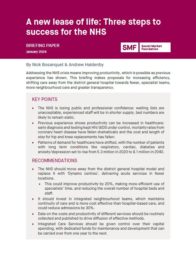The crisis in the NHS, with unacceptable waiting lists and ever increasing emergency admissions, shows the current model is failing to meet modern healthcare needs. This briefing proposes a new model to increase efficiency, shifting care away from the district general hospital towards fewer, specialist teams, more neighbourhood care and greater transparency.
KEY POINTS
- The status quo in the NHS is untenable: waiting lists are unacceptable, experienced staff will be in shorter supply, bed numbers are likely to remain static.
- Despite fatalism in some quarters, previous experience shows productivity can be increased in healthcare: early diagnosis and testing kept HIV/AIDS under control, mortality rates from coronary heart disease have fallen dramatically and the cost and length of stay for hip and knee replacements has fallen.
- Patterns of demand for healthcare have shifted, with the number of patients with long term conditions like respiratory, cardiac, diabetes and anxiety/depression set to rise from 5.3 million in 2020 to 9.1 million in 2040.
RECOMMENDATIONS
- The NHS should move away from the district general hospital model and replace it with ‘Dynamo centres’, delivering acute services in fewer locations.
- This could improve productivity by 20%, making more efficient use of specialists’ time, and reducing the overall number of hospital beds and staff.
- It should invest in integrated neighbourhood teams, which maintains continuity of care and is more cost effective than hospital-based care, and could reduce admissions by 30%.
- Data on the costs and productivity of different services should be routinely collected and published to allow for diffusion of effective methods.
- Integrated Care Services should be given control over their capital spending, with dedicated funds for maintenance and development than can be carried over from one year to the next.

DOWNLOAD THE BRIEFING: PDF
